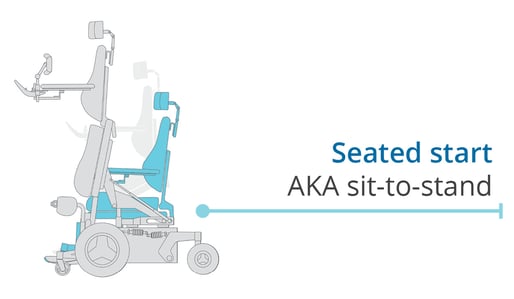Our last two blogs in the power wheelchair series have been about power seat functions. We know that power seat functions are the different positions a power wheelchair can achieve and today we're taking a closer look at power standing.
Power Standing Wheelchair
There are manufacturers who have recognized the important health risks to prolonged sitting and developed technology that allows power wheelchair users to stand. Some funding sources question whether the ability to stand is medically necessary for a full-time wheelchair user and the chart below outlines the multiple medical and physical benefits of standing.
| Definitions | Clinical benefits may include |
|
Power standing "is capable of raising the occupant from a seated to a standing position by changing the orientation in space of all the primary seating support surfaces" (Waugh & Crane, 2013, p. 48) When considering standing, it is important to consider the need for the ability to customize the standing sequence and angles to address a client's unique ROM and functional needs
|
Access to multiple environmental levels for improved participation in MRADLs |
|
Spasticity control |
|
|
Pain reduction in the trunk and extremities |
|
|
Bowel motility |
|
|
Bladder emptying |
|
|
Range of motion improvement in the lower extremities and hips |
|
|
Cardiovascular/respiratory improvement through movement |
|
|
Pressure management while allowing function |
|
|
Shorter, more frequent standing & dynamic loading may improve bone mineral density |
When considering standing it’s important to understand that not all power standing wheelchairs are alike. Make sure that the chair allows for adjustments to accommodate individual range of motion limitations and supportive needs and is not a “cookie cutter” option. Also look for a power standing wheelchair that allows the standing sequence to be customized for individual needs. For more on what sets the Permobil F5 Corpus VS apart, check out Lessons Learned in Our Many Years of Developing Standing Power Wheelchairs.
|
* Ask your provider the following questions:
|


In addition to medical and physical benefits, there are psychosocial benefits of standing that wheelchair users report. Think about the ability to look someone in the eye when speaking, seeing what others see when waiting in line at a show, being able to reach for a glass independently to get a drink of water. All of these things can impact a person deeply. Per Udden said it best when he founded Permobil:
“Every person has the right to have his or her disability compensated as far as possible by aids with the same technical standard as those we all use in our everyday lives.”
Join us next time in our power wheelchair blog series as we take a look at the different power seat function combinations available on the different power wheelchair base options.
References:
Waugh, K. & Crane, B. (2013). Glossary of wheelchair terms and definitions, Version 1.0. Assistive Technology Partners.
 Stacey Mullis, OTR/ATP
Stacey Mullis, OTR/ATP
Director of Clinical Marketing
Stacey serves as Director of Clinical Marketing for Permobil. A practicing OTR for over 20 years, she has experience in school-based pediatrics, inpatient rehabilitation, long term care, and home health. With her interest in wheelchair seating and positioning, Stacey engaged the challenges of providing appropriate seating in various clinical settings. She now uses this experience to develop programs and resources to educate clinicians on the principles of seating and wheeled mobility. She is passionate about equipping clinicians and through her previous role as Director of Clinical Education with Comfort Company and now with Permobil she has taught nationally and internationally to increase therapist capacity in this specialty area. Mullis graduated from Western University in London, Ontario, Canada with a BA Linguistics and BSc Occupational Therapy. She is a member of the NCOTA, CTF Executive Board, NRRTs, RESNA, and AOTA.
 Angela Regier, OTD, OTR/L, ATP/SMS
Angela Regier, OTD, OTR/L, ATP/SMS
Clinical Education Manager
Angela Regier, OTD, OTR/L, ATP received her doctorate of occupational therapy from Creighton University in 2007 and is a RESNA-certified assistive technology professional. Regier joined Permobil in 2017 as a Clinical Education Manager for the western region. Prior to joining Permobil, Regier was at Craig Hospital in Englewood, Colorado where her career focused on inpatient and outpatient spinal cord injury rehabilitation. Prior to leaving Craig Hospital, she was supervisor of the Wheelchair Seating and Mobility Clinic where she provided comprehensive seating and mobility interventions for individuals with acquired brain and spinal cord injury. Regier has published and speaks on the topic of seating and mobility for acquired brain injury and spinal cord injury. She has also served as an adjunct faculty for the Creighton University Entry-Level Distance OTD Program (Regis) in Denver, Colorado.


